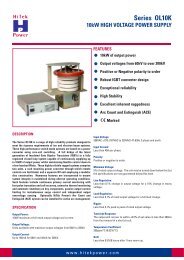Series PM10 Photomultiplier Power Supply Modules ... - HiTek Power
Series PM10 Photomultiplier Power Supply Modules ... - HiTek Power
Series PM10 Photomultiplier Power Supply Modules ... - HiTek Power
Create successful ePaper yourself
Turn your PDF publications into a flip-book with our unique Google optimized e-Paper software.
<strong>Series</strong> <strong>PM10</strong><br />
PHOTOMULTIPLIER POWER SUPPLY MODULES<br />
Using single fixed resistor:<br />
Connect a resistor between Pin 9 and Pin 8 using the internal impedance<br />
(22kΩ ±1%) as potential divider.<br />
Using two fixed resistors:<br />
Connect a resistor between Pin 9 and Pin 8, connect an additional<br />
resistor between Pin 8 and Pin 6.<br />
Note: Internal impedance 22kΩ (±1%).<br />
Current Control:<br />
Current Demand: 0 to 10V for 0 to max output current ±2%.<br />
Note: If left open, circuit supply assumes maximum<br />
current capability.<br />
Input Impedance: 1MΩ internal pull-up, to a +15V rail.<br />
Using DAC or OP-AMP:<br />
Connect output to Digital to Analogue Converter (DAC) or Operational<br />
Amplifier to Pin 4 and 0V to Pin 6.<br />
Using potentiometer and internal reference:<br />
Connect the high end (clockwise) of potentiometer to Pin 9, connect<br />
low end (counter clockwise) of potentiometer to Pin 6, connect wiper<br />
of potentiometer to Pin 4.<br />
Using potentiometer and external 10V reference:<br />
Connect the high end (clockwise) of potentiometer to external 10V<br />
reference, connect low end of potentiometer (counter clockwise) to Pin<br />
6 and external 10V reference return, connect wiper of potentiometer to<br />
Pin 4.<br />
Using two fixed resistors:<br />
Connect a resistor between Pin 9 and Pin 4, connect an additional<br />
resistor between Pin 4 and Pin 6.<br />
Monitors:<br />
Voltage Monitor: 0 to 10V ±2% or ±100mV, whichever is greater, for 0<br />
to rated output voltage.<br />
Output Impedance: 10KΩ ±1%.<br />
Current Monitor: 0 to 10V ±2% or ±100mV, whichever is greater, for 0<br />
to rated output current.<br />
Output Impedance: 10KΩ ±1%.<br />
Inhibit:<br />
Disable: 0 to 0.8V =OFF<br />
Enable: 2.2V to 24V =ON<br />
Open circuit =ON<br />
Stability:<br />
Less than 50ppm per hour at constant ambient temperature and rated<br />
output power after 1 hour warm-up.<br />
Temperature Coefficient:<br />
Less than 25ppm/oC at max output power.<br />
Operating Temperature:<br />
0oC to 50oC at up to 90% RH non-condensing.<br />
Storage Temperature:<br />
-35oC to +70oC.<br />
Altitude:<br />
Sea level to 2000 metres (6500 feet).<br />
Reliability:<br />
Mean Time Between Failure (MTBF) is greater than 100,000 hours. In<br />
accordance with MIL-HDBK-217F.<br />
Protection:<br />
The <strong>PM10</strong> is protected against continuous short circuit and flashover.<br />
Safety:<br />
Meets the requirements of the Low Voltage Directive, 73/23/EEC, by<br />
complying with BS EN60950 when installed as a component part of<br />
compliant equipment. Units are CE marked accordingly.<br />
RoHS:<br />
The <strong>Series</strong> <strong>PM10</strong> meets the requirements of EU Directive 2002/95/EC<br />
on the Restriction of use of certain Hazardous Substances in Electrical<br />
and Electronic Equipment (RoHS).<br />
Mechanical Specification:<br />
Dimensions: See outline drawing.<br />
Weight: <strong>PM10</strong>/102 & <strong>PM10</strong>/202: 0.4kg (0.88 lb)<br />
<strong>PM10</strong>/302 & <strong>PM10</strong>/502: 0.7kg (1.54 lb)<br />
Construction: Fabricated alloy with black painted finish.<br />
Earthing: Case internally connected to 0V.<br />
Output connection: 600mm long screened flying lead (see drawing).<br />
Output and Ordering Information:<br />
Model no Output<br />
Voltage<br />
Output<br />
Current<br />
Current<br />
Load<br />
Regulation<br />
Ripple<br />
pk-pk<br />
Output<br />
Stored<br />
Charge<br />
<strong>PM10</strong>/102* 10V-1kV 10mA 0.05% 10mV




